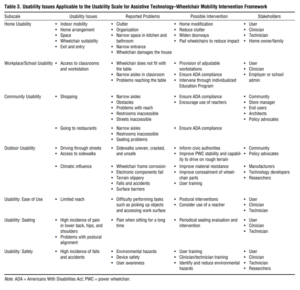As of 2015, there were 2.7 million wheelchair users in the US [1], and according to the CDC, 13.7% of US adults have some form of disability relating to their mobility [2]. Assistive mobility technology is a very large market, and many people stand to benefit from improvements in this field. The aim of this project is to make a quality of life change for people with mobility issues by allowing current wheelchair users to have more independence and perhaps even opening the door to the mobility-impaired to feel more comfortable with the idea of transitioning to a wheelchair.
Improvements to wheelchairs is a broad category, but reaching a wide audience was a priority. To reach a wide audience, the project would benefit from being designed as a device that could be acquired and installed at a relatively low cost, weight, and could be attached to an existing wheelchair. Wheelchair users face a variety of issues, but this project must have a more specific focus. Table A.1 (See Below) is from a study conducted to measure the usability of assistive technology from a multi-contextual perspective. This table demonstrates some of the major identified challenges wheelchair users tend to face. Notably, users’ experience issues are mainly within their community and outdoor environments, rather than at their homes or workplaces. Among challenges posed by outdoor environments include driving through streets, access to sidewalks, and climatic influences [3]. Ramps specifically have been identified as an issue for some wheelchair users within their communities. Stairs were also a specific issue identified for wheelchair users [4]. These challenges and issues are intended to be mitigated by the design of the wheelchair add-on design. Simultaneously, accessibility issues created by the add-on itself must be minimized and taken into consideration [5]. For example, Table A.1 (See Below) emphasizes the accessibility issues associated with restrooms or narrow aisles [3] and ultimately any add-ons for this project should not worsen the accessibility of a manual wheelchair. With the research presented above, there were two main interests: steep inclines and declines and stair climbing. The focus was centered on inclines and declines in part because of safety concerns for stair climbing as well as the difficulty involved with creating a stair climber that could also be an attachment for an existing wheelchair. With the focus solidified, a strong understanding of the audience is still required.
While wheelchairs do allow those who cannot walk or have limited mobility to travel on their own, manually operated wheelchairs can put a serious strain on a person’s body, especially their upper body. Injuries are not uncommon; between 42% and 66% of manual wheelchair users experience shoulder pain from frequent use of the wheelchair [6]. These issues can be concerning for both wheelchair users and those considering using wheelchairs. There are powered wheelchairs, but they are bulky, expensive, and can make the user feel as if they are giving up what mobility they still have. The goal of this project is to create a device that can be added to an existing manual wheelchair that is relatively low cost and low weight that will assist the user if they become tired or sore, but does not completely take away the feeling of autonomy. This device will help lower the amount of fatigue experienced by manual wheelchair users and lower the barrier to entry for those considering a modestly priced wheelchair who fear being unable to independently push it. Overall, the success of this project means the ability to safely implement an accessory allowing many current or new wheelchair users to experience more independence and ease of mobility even when trying to ascend and descend steep slopes.
Assuming the project is successful, this new system still needs to be made available to the public. An attempt could be made to file a patent and sell production rights, which if possible could be beneficial for the team, but may limit the market of consumers. The work could also be made open source, which would give opportunities to others to build off what was done in this project or produce similar products cheaply. Plans for this last stage of the project have not yet been discussed. Ultimately, the motivation of this project is to use engineering knowledge to make a positive difference in the lives of millions of people by improving the wheelchair user experience.
Table A.1 Usability Issues Applicable to the Usability Scale for Assistive Technology (from a usability study conducted to measure the usability of assistive technology from a multi-contextual perspective) [6].
